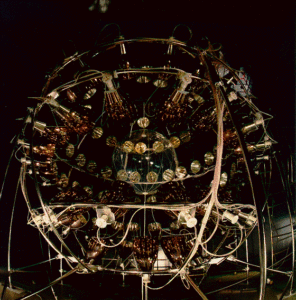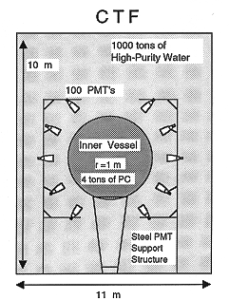
The Borexino Counting Test Facility (CTF for short) has been a scaled-down prototype of the Borexino detector. It consisted of 4.3 metric tons of liquid scintillator shielded by 1000 metric tons of high purity water contained in a large cylindrical steel tank.
One hundred photomultiplier tubes (PMTs) installed on a steel support structure known as the “Open Structure” was used to detect the photons emitted by the scintillator. The PMTs were equipped with mu-metal cones to shield them from Earth magnetic field and concentrators to increase light collection efficiency.
The scintillator – a mixture of an aromatic solvent (pseudocumene, “PC” for short) and 1.5 gr/liter of PPO as a fluor – was contained in a 0.5 mm thick nylon balloon.
The apparatus was coupled to a water ultra-purification facility to produce the low radioactivity water shield and to a scintillator purification system. The scintillator was purified via water extraction, distillation and gas stripping.
A 1.8 m2 muon detector positioned on the top of the water tank was used to test the muon identification capabilities of the CTF detection system.

The CTF experimental activities started in 1994 (installation) and continued throughout ’95 (data taking) and ’96 (source calibration program). The results of the Counting Test Facility in terms of U, Th and 14C contamination (internal background) confirmed that the radiopurity goals of the experiment had been reached:
- Uranium chain contamination (more appropriately 226Ra) has been measured to be at most 3.5(∓1.3)*10-16
- Thorium contamination was found to be 4.4(∓1.5)*10-16
- Carbon-14 contamination was measured to be 1.94(∓0.09)*10-18 (14C/12C)
thus indicating that the extreme radiopurity required by Borexino could be reached on the necessary large scale.
For more details please refer to these article:
A large-scale low-background liquid scintillation detector: the Counting Test Facility at Gran Sasso
Subsequently the CTF was drained, renewed and improved, with the replacement of the PMTs and of the inner vessel, now including a second larger concentric nylon vessel to further reduce contamination in the fiducial volume (a two-vessels design similar to that adopted also for the Borexino detector). The renewed CTF was sometimes referred to as “CTF2” or “CTF-II”. It have been operated for several more years to conduct various other tests and measurements (including that of a possible alternative liquid scintillator, PhenylXylylEthane AKA “PXE” for short) before being decommissioned.
Here you can watch a nice time-lapse video of “CTF2” filling operation (May 22 – June 18, 2001), as viewed from the CTF internal CCTV camera.
Read more: /tag/ctf/